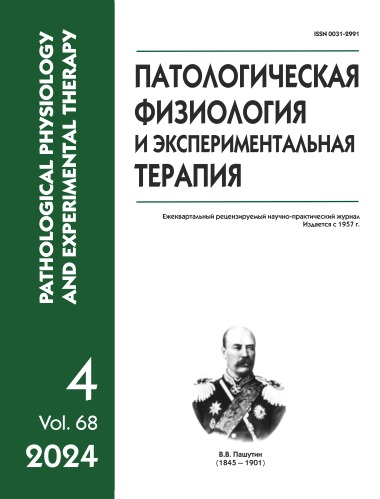Stimulation of innate immune mechanisms in human donor corneas
Abstract
Introduction. This study evaluated the ability of corneal tissue to activate the innate immune system for viral decontamination of a corneal graft. It is well known that viral invasion activates the innate immune system. However, there is a shortage of publications on the ability of corneal tissue to produce its own interferons. Thus, the aim of this study was to evaluate the ability of cadaveric human donor corneal tissue to produce its own type 1 interferons (IFN-α and IFN-β) in an in vitro experiment on cell cultures of corneal keratocytes and corneal fibroblasts.
Мethods. To achieve this aim, we used cadaveric human donor corneas and isolated and cultured corneal keratocytes and corneal fibroblasts. An interferon inducer was added to the culture medium of the experimental group to activate the innate immune system. Cells cultured in a complete culture medium served as a control. At the end of the experiment, an immunohistochemical study was performed to determine the phenotypic transformation and an enzyme immunoassay to detect endogenous IFN-α and IFN-β.
Results. The culture medium with 1 mg/100 ml of the interferon inducer added to the cultured keratocytes and fibroblasts induced the production of type 1 interferons (IFN-α and IFN-β), with a significantly greater amount of interferon released in the fibroblast cell culture compared to the keratocyte cell culture (p<0.05).
Сonclusions. The interferon inducer added to the growth medium for 24 hours activated the innate immunity mechanism in corneal cells and tissue, significantly more in the fibroblast cell culture, without causing any change in the cell phenotype.
Downloads
References
2. Grüter W. Experimental and clinical studies on so-called corneal herpes / W. Grüter // Berichte über die Versammlung der Deutschen Ophthalmologischen Gesellschaft. – 1920. – № 42. – P. 162-167.
3. Каспаров А.А. Современные аспекты лечения герпес-вирусного кератита / А.А. Каспаров // Клин. офтальмология. – 2000. – № 2. – С. 59-63.
4. Майчук Ю.Ф. Оптимизация фармакотерапии воспалительных болезней глазной поверхности / Ю.Ф. Майчук // Российский офтальмологический журнал. – 2008. – № 3. – С. 18-25.
5. Haller O. A tribute to Jean Lindenmann, co-discoverer of interferon (1924-2015) / O. Haller // Cytokine. – 2015. – Vol. 76, № 1. – P. 113-115.
6. Керимов Т.З., Соболев В.П., Соболева М.А., Гаврилова Н.А., Борзенок С.А. Патофизиологические механизмы иммунологической деконтаминации вируса простого герпеса 1 типа из роговицы. Патогенез. 2020; 18(3): 4-11.DOI: 10.25557/2310-0435.2020.03.4-11.
7. Jang J.H. An Overview of Pathogen Recognition Receptors for Innate Immunity in Dental Pulp / J.H. Jang, H.W. Shin, J.M. Lee [et al.] // Mediators Inflamm. – 2015. – Vol. 2015. – P. 794143.
8. Paludan S.R. Recognition of herpesviruses by the innate immune system / S.R. Paludan, A.G. Bowie, K.A. Horan [et al.] // Nat. Rev. Immunol. – 2011. – Vol. 11, № 2. – P. 143‐154.
9. Patel M.C. Novel drugs targeting Toll-like receptors for antiviral therapy / M.C. Patel, K.A. Shirey, L.M. Pletneva [et al.] // Future Virol. – 2014. – Vol. 9, № 9. – P. 811-829.
10. Mossman K.L., Ashkar A.A. Herpesviruses and the innate immune response. Viral Immunol. 2005; 18(2): 267-281. DOI: 10.1089/vim.2005.18.267.
11. Борзенок С.А. Алгоритм заготовки трупных роговиц человека для трансплантации / С.А. Борзенок, Б.Э. Малюгин, Н.А. Гаврилова [и др.] // М. : ГБОУ ВПО МГМСУ МЗ РФ, 2016. – 20 с.
12. Борзенок С.А. Медико-технологические и методологические основы эффективной деятельности глазных тканевых банков России в обеспечении операций по сквозной трансплантации роговицы: дисс. … докт. мед наук: 14.01.07 / Сергей Анатольевич Борзенок. – М., 2008. – 308 с.
13. Ebihara N. Expression and function of toll-like receptor-3 and -9 in human corneal myofibroblasts / N. Ebihara, S. Yamagami, L. Chen [et al.] // Invest. Ophthalmol. Vis. Sci. – 2007. – Vol. 48, № 7. – P. 3069-3076.
14. Koujah L. Pathological processes activated by herpes simplex virus-1 (HSV-1) infection in the cornea / L. Koujah, R.K. Suryawanshi, D. Shukla // Cell Mol. Life Sci. – 2019. – Vol. 76, № 3. – P. 405‐419.






